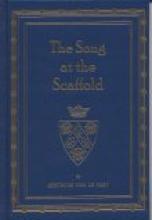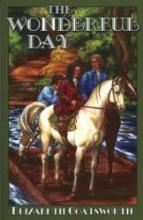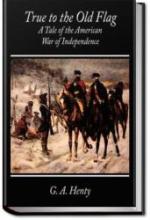18th century Historical Fiction
The Song at the Scaffold
Number of pages:
110 pages
Copyright:
1931
Publisher:
Lepanto Press
Binding:
Sewn Hardcover
Subject(s):
Setting:
Grade / Age level:
Review:
This novelette, set at the time of the French Revolution, follows the lives of the nuns of the Carmelite convent at Compiegne during those troubled times, all the way to their martyrdom at the guillotine. Despite the rather short length, the novel is very deep and very moving. The author, rather than having the charcters preach to the reader, created a story which causes the reader to consider some very substantial spiritual issues - suffering, pride, fear, and how God works in our lives. Far from a depressing tale, we are shown how the Christian spirit becomes stronger in the face of great evil. However, we also see a warning note very applicable to our own times - that human nature alone is not sufficient and that when we abandon God and religion a very frightening and chaotic side of mankind can be revealed.
The story is quite valuable from an historical perspective - particularly as we view the French Revolution from a Catholic perspective. This book would be appropriate for high school (probably Junior or Senior year) and would be excellent for teens and parents to read together in order to discuss the many facets of the story.
The story is quite valuable from an historical perspective - particularly as we view the French Revolution from a Catholic perspective. This book would be appropriate for high school (probably Junior or Senior year) and would be excellent for teens and parents to read together in order to discuss the many facets of the story.
Perspective:
Catholic
Reviewed by:
First reviewed:
1998-99
The Wonderful Day
Subject(s):
Setting:
Grade / Age level:
Review:
Reviewed by:
First reviewed:
7-12-06
True to the Old Flag
Subject(s):
Setting:
Grade / Age level:
Review:
What would you say to a historical novel filled with action and adventure? What would you say to a book written with boys in mind by an author famous for his morally strong and upright heroes? What would you say to a book that gives the “other side” of the story?
Well, I would say – “sounds wonderful; bring it on!”
And this book, True to the Old Flag: A Tale of the American War for Independence, by G. A. Henty fulfills all these descriptions. His book is filled with action and adventure, from pre-Revolution events to post-Revolution occurrences. The book is definitely written with boys as the implied audience; and yes, his main character is morally strong, upright and virtuous. Further, this book is written from a loyalist viewpoint; his main character is Harold Wilson, the only child in a family of loyalists living in New England during the Revolution. Wilson serves under British officers fighting the fight as only the British can.
George Alfred Henty (1832-1902), a novelist and “special correspondent”, was an avid imperialist – he felt that Britain’s conquering of the world was a great goal. Henty wrote this novel in 1885 in the heyday of Queen Victoria’s empire building. The ideal of British imperialism permeates True to the Old Flag. Snippets of the author’s British prejudice do creep in such as:
…it is probably that these terms (of compromise) might have been accepted (by Colonists wavering between loyalty to England and independence) had it not been for the intervention of France. That power had all along encouraged the rebellion. She had smarted under the loss of Canada, … she was glad to assist in any movement which could operate to the disadvantage of this (England) country. (pg 261)
We first meet Harold Wilson when he is visiting his maternal relatives out “west” in the wilderness of 1774 Michigan. Here the first thing Wilson does is save a young cousin from capture by some Indians; an act of bravery and intelligence that wins the heart of his young cousin and the gratitude of his aunt and uncle.
When the war starts a couple of years later, Wilson can only fight on the British side. His family members (his father is from England and his mother, although born in America, accepts her husband’s ideals) are loyalists and still have many ties to England. Wilson, now a young man of 18, goes off to fight with Howe, Clinton and Cornwallis.
Wilson sees it all and throughout the novel helps the reader see the major battle-fronts. From Lexington and Bunker Hill to Trenton and Saratoga; from Savannah to Cowpens and Guildford Court House the history is told through the eyes and ears of the young hero. The reader crawls through enemy lines with Wilson, spends time in an American prison with Wilson and goes to England with the now-defeated Wilson.
This is a great book for a living history study of the Revolution from an out of the ordinary point of view. The reader needs to remember that this book was written in 1885 when prejudices and bigotry were still prevalent – some of the descriptions of the African-Americans, Native Americans and others would not be allowed in a book written today. Another small quibble is that the author occasionally loses the story in his desire to describe the battles; the voice becomes that of an outsider rather than Wilson, and the book turns a bit textbook-ish at these points.
This book is definitely a great read for 4th-8th grade readers wanting to know a bit more about the American Revolution and how some Americans could take up the old flag against the new.
Some prejudicial/bigoted remarks about African-Americans, Native Americans and others; also the author occasionally loses his "narrator" voice and becomes text-bookish with his descriptions of the battles.
Reviewed by:
First reviewed:
11-2-2008
Hope's Revolutionary War Diary
Number of pages:
107 pages
Publisher:
Scholastic
Binding:
Softcover
Subject(s):
Setting:
Grade / Age level:
Review:
For young readers, this is an extremely well written account of the American Revolution. Written as a diary of a young girl, the book opens with Hope's family living with her relatives in Valley Forge. This quickly changes, however, when her family moves back to Philadelphia.
I like this book because it weaves interesting information about this period of time throughout the story, making it an educational read. Gregory not only portrays the drama and suspense of that period, but also accurately depicts the everyday occurrences and unusual habits in daily life. In the beginning, both Hope's father and brother are gone. When they return, she finds out the hardships they have gone through. Even though this is an educational book, it is easy to read and follows more than one interesting story line. In the beginning, for example, her brother has run away to join the army and no one knows how he is. She is also concerned about her father when he is gone. Will he return home? Then to make matters worse, her best friend is not allowed to talk to her, because her friend's family sympathizes with the other side. The family also has the unpleasant task of feeding and boarding some British soldiers. Will she accidentally reveal her sympathies?
The My America Series is shorter than the Dear Diary series also published by Scholastic.
I like this book because it weaves interesting information about this period of time throughout the story, making it an educational read. Gregory not only portrays the drama and suspense of that period, but also accurately depicts the everyday occurrences and unusual habits in daily life. In the beginning, both Hope's father and brother are gone. When they return, she finds out the hardships they have gone through. Even though this is an educational book, it is easy to read and follows more than one interesting story line. In the beginning, for example, her brother has run away to join the army and no one knows how he is. She is also concerned about her father when he is gone. Will he return home? Then to make matters worse, her best friend is not allowed to talk to her, because her friend's family sympathizes with the other side. The family also has the unpleasant task of feeding and boarding some British soldiers. Will she accidentally reveal her sympathies?
The My America Series is shorter than the Dear Diary series also published by Scholastic.
Reviewed by:
First reviewed:
9-3-02



